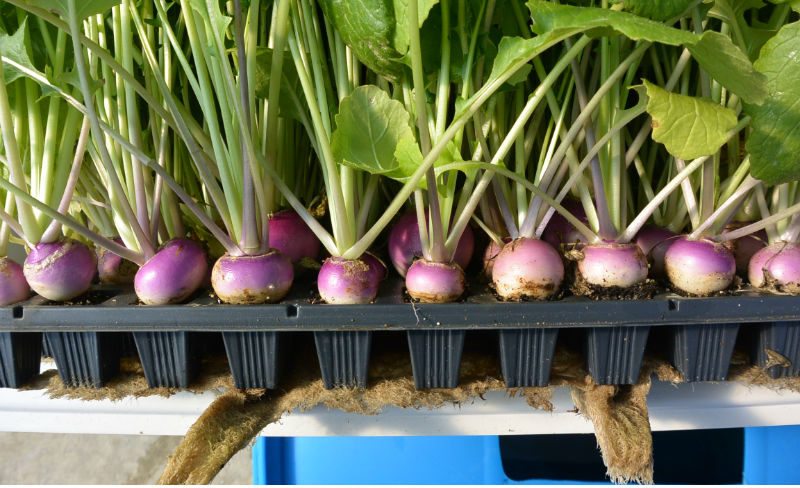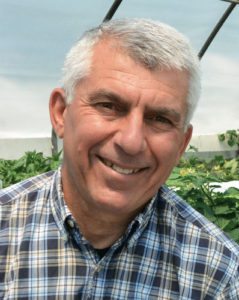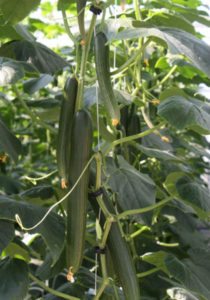
Hydroponic Vegetable and Herb Production
Joining me this month is Chris Currey, assistant professor at Iowa State University. Chris and I met in 2010 when he was a HortScholar during the then OFA Short Course. Two years later we both spoke at a conference in Saskatoon, Saskatchewan, when he was completing his doctoral work under Roberto Lopez then at Purdue University. Since his appointment at Iowa State, Chris has become a prolific author in greenhouse trade publications.
Peter: Chris, welcome and thanks for teaming up with me today. I’d like to start with you defining hydroponics so we can discuss what it is and what it is not.

Chris: Peter, first I’d like to thank you for inviting me into your conversations. As to defining hydroponics, let’s start with the most literal definition and look at the etymology of the word. Hydroponics is a combination of the Greek words hydro, meaning water, and ponos, or working; this gives you “working water.” Hydroponic production is soilless cultivation of plants, or growing without mineral soil. Within this broad definition, petunias and poinsettias grown in containers using soilless substrate comprised of peat and perlite and irrigated with a hose and fertilized with water-soluble fertilizer would indeed be hydroponic cultivation.
However, in a more practical and everyday definition of hydroponics, I tend to think of systems that generally have less substrate relative to the plant size. Think of the size of the root system relative to the shoot system for a hydroponic tomato that may be 10 or 12 feet tall compared to a geranium in a 4-inch pot. This greater proportion of shoot relative to roots results in another feature of hydroponic systems — frequent irrigation. Three days may go between irrigating containerized plants. Alternatively, hydroponically grown plants are irrigated usually a minimum of once per day, several times or frequently throughout the day, or continuously.
Peter: Thanks for that technical definition, Chris; stretching it into its practical realm allows me to introduce my perspective on the difference between botany and horticulture to emphasize your strict versus practical interpretation. To me botany is the pure study of plants, while horticulture is the study of growing plants for profit. Theory versus practice, strict versus practical … the two of us agree that in horticultural settings we can operate under a less than literal definition of hydroponic culture. In the end it’s all about business — managing an operation and making a profit.

That said, and referencing your citation of “growing without mineral soil,” I think many still think of modern soilless media as still being in the mineral soil category. They may be assuming that peat lite mixes are disqualifiers regarding hydroponic culture. Kim Williams and I had an interesting conversation in the June issue about organic growing — what does and does not qualify. We agreed that the word organic has taken on an unintended, purely marketing meaning by consumers that sometimes results in unrealistic expectations. My next co- author will be Dan Jacques from SunGro Horticulture; we’re going to discuss advances in growing media and the subject of hydroponics is certain to come up.
So, my botany-horticulture reference fits as follows; a botanist might exclude certain input factors from qualifying as hydroponic whereas a horticulturist might operate under a looser, more inclusive guideline in his/her effort to run a profitable business.
In my “from flowers to food” research, most of the crops investigated do indeed fall into the hydroponic category, in my opinion, even with peat lite mixes in use. I like your explanation of relative shoot to root mass, that’s an excellent way to describe hydroponics. Working with root crops in plug trays has presented me with another way of describing the difference between traditional and hydroponic culture.
In Figure 1 (pictured above), most of the root mass of the plug tray of turnips developed outside the cells and growing medium. Each cell’s medium merely provided the seed with, first, a stable germinating environment and, second, a path down through the drainage hole into the plug tray-flood tray interface. Most of the root mass developed in this nutrient-air-rich environment and the growing medium in the cell was almost insignificant. Isn’t it interesting that both of us cite the root system as a focal point in our respective, practical definitions of hydroponics?
Chris: I would like to ask you for some perspective on “from flowers to food” that draws on what you have learned during your own transition from ornamental to edible crops, as well as watching others make the transition. One of the things I hear growers talking about is getting into growing tomatoes. What do you think about that learning curve? I have been really intrigued by your root crop work. What inspired you to work with those crops?
Peter: Answering your last question first helps me explain my transition from ornamental to edible crops. My very first crop of radishes in plug trays was grown over 25 years ago, circa 1990. At the time one of my responsibilities in the family bedding plant operation was sowing seeds and growing plugs for our retail operation. During peak weeks during winter months sowing several hundred 288 plug trays each week kept me busy.

One day an idea washed through my brain…why not sow radishes in a 72-cell tray? Growers who have heard me speak about Florel over the years are familiar with my, “I wonder what would happen if…” perspective on research. Twenty-five years later I-wonder-what-would-happen-if turned into a full fledged research project. Having grown up on a family vegetable farm that shifted to ornamentals during the 70s to secure higher margins, for me it was a case of “you can take the boy off the farm but you can’t take the farm out of the boy.”
Growers expressing a desire to jump into hydroponic greenhouse tomatoes, in my opinion, may be jumping the gun initially. I believe many of these growers should focus on shorter term, quicker cycle crops initially. Is this how you see things as well?
Chris: I too feel like short-term crops are good to cut your teeth on. Lettuce and herbs will provide the opportunity to learn some of the basic tenets of hydroponic production, like managing nutrient solution, while providing a quick recovery time in the case of mistakes are made. While leafy greens may not serve as a great model for learning about vine management, they are still shorter term crops that you can cut your teeth on.
To move into vine crops, cucumbers are a great crop to learn vine management techniques on. With a crop cycle of two to three months after transplanting, this is anywhere from one-half to one-third the crop time for tomatoes. Once again, mistakes are easier to manage on a crop with that short of a production cycle. I would much rather make mistakes on a crop of cucumbers than a crop of tomatoes or peppers.
Peter, do you see any parallels between cut flower production, which has gone from domestic greenhouses to in-ground production offshore, and hydroponic food production, which is bringing the production of foods commonly grown in-ground offshore to domestic greenhouses? I was visiting a large cut flower grower in Minneapolis and looking at roses, alstromeria and gerbera daisies grown hydroponically in their greenhouses and was thinking about the relationship between the production systems or techniques.
Peter: What an interesting question. Much of my focus on the locally grown food movement is on the sustainability of various agricultural systems. Agricultural experts agree that our industrial model of food production is less sustainable than once thought. Returning a portion of this less sustainable production to the local, family farm has become very important to me having grown up on one and experiencing first hand how industrial farming eroded profit margins forcing many families into ornamental crop production. Not that it was a consolation to shift into flowers and bedding plants, most of us are grateful we experienced ornamental crop production. Poetically, it’s become a “what goes around comes around” story as many bedding plant growers are now shifting back into food crops.
Chris: What goes around comes around, indeed! You were probably excited to get rid of your vinyl records, while I love collecting them. Dig out those old bellbottoms, Peter! I have seen an old photograph from around 1910 of cucumbers being grown in a greenhouse just outside the Twin Cities in Minnesota, and the growers were the Bachmanns who would later become renowned for their poinsettias. In a number of years, we may see the trend “from food to flowers!”
Peter, thanks again for the invitation and it has been a pleasure talking with you!
Peter: That’s a perfect closing perspective, Chris. I should have called you last year when I tossed my vinyl record collection after years of dust accumulation. Regarding the return of bellbottoms … dream on, grasshopper.


 Video Library
Video Library 




















